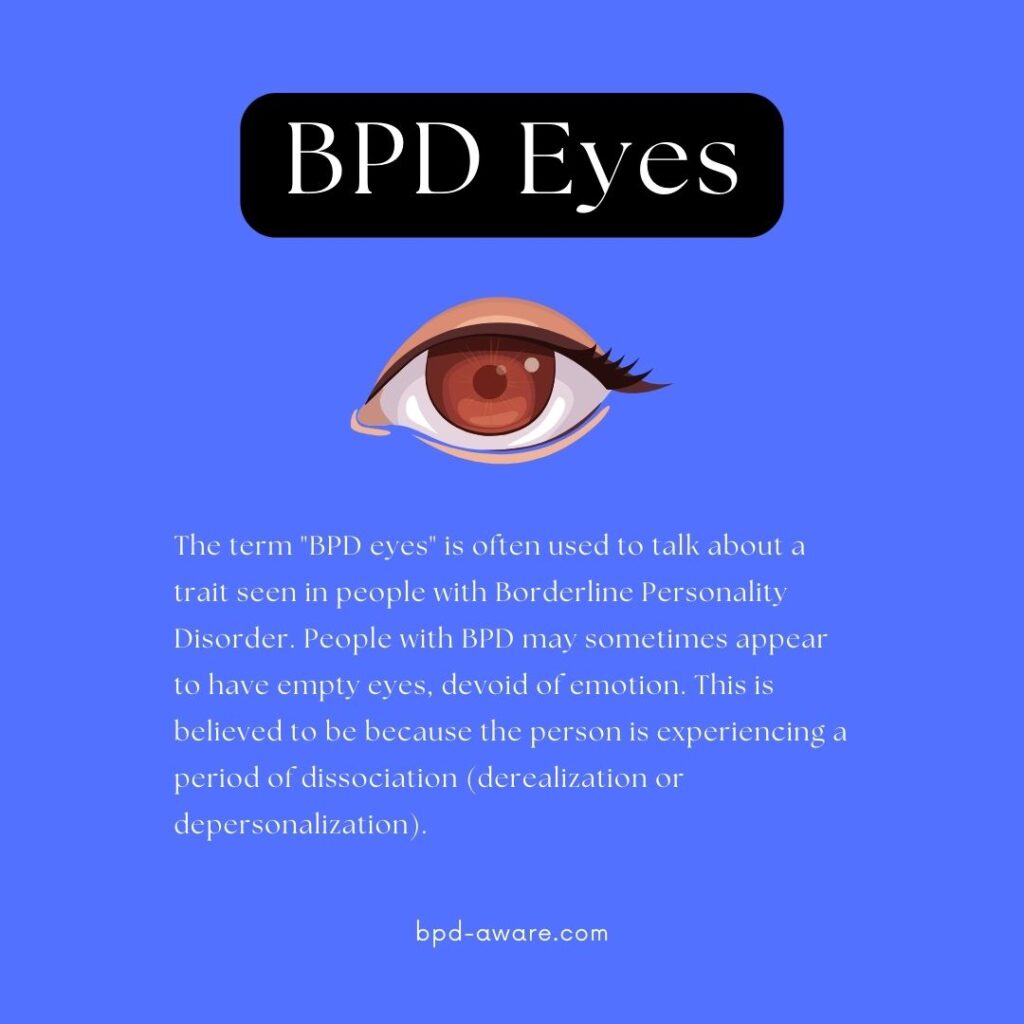Exploring BPD Eyes: Insights & Understanding - The Ultimate Guide
Can a simple glance truly unveil the complexities of the human psyche? The eyes, often hailed as the windows to the soul, may offer a unique lens through which to understand Borderline Personality Disorder (BPD) and its intricate manifestations. This article delves into the often-overlooked world of "BPD eyes," exploring their significance in masking behaviors, emotional regulation, and the challenges faced by those living with this complex condition. We will explore how these visual cues might offer a glimpse into the inner turmoil of individuals with BPD and the impact they have on interpersonal relationships.
A TikTok video from fizzingstarswithcesca (@fizzingstarswithcesca) ignited a conversation: explore the world of bpd eyes and their significance in masking behaviors. Learn more about bpd awareness and gain insight into the explanation behind empty bpd eyes. #bpdeyes #bpdeyesexplained #bpd #bpdtiktok #masking #bpdawareness #eyes #explained. This video, like many others, sought to shed light on the experiences of individuals with BPD, emphasizing the connection between emotional states and their visual expression. "We focus these sparkling eyes on our unsuspecting prey and they are lost!"
The concept of "BPD eyes" encompasses a range of visual characteristics, including a perceived lack of emotional depth, described by some as "empty eyes." These eyes can appear blank, sad, or intensely focused, reflecting the often-fluctuating and vulnerable emotions experienced by those with BPD. The observation of darker eyes during periods of dysphoric mania is another facet of this phenomenon. One individual shared, "Once I started asking clients to notice eye changes in a loved one, I heard many stories of how dysphoric mania turned the eyes 'black.'"
- Bryce Adams Leaks What You Need To Know New Info
- Zendaya Emma Stone Keoghan Hot Movies You Need To See
The experience of BPD is often intertwined with chronic instability in interpersonal relationships. This instability can exacerbate other symptom dimensions of the disorder and can interfere with treatment engagement. Social impairments, often characterized by difficulties in navigating social situations and forming healthy relationships, are a prominent aspect of BPD. As a result, facial emotion recognition paradigms have been employed to investigate the bases of interpersonal impairments in BPD, yielding mixed results.
The following table provides a summary of key features associated with Borderline Personality Disorder (BPD) and related concepts:
| Feature | Description |
|---|---|
| BPD Eyes | A perceived phenomenon related to Borderline Personality Disorder, characterized by visual cues like "empty eyes," changes in eye color (e.g., appearing darker), and/or intense or fluctuating expressions. |
| Emotional Dysregulation | Difficulty in managing and regulating emotions, leading to intense emotional responses, mood swings, and heightened vulnerability to emotional distress. |
| Dissociation | A psychological state where a person feels detached from their body, emotions, or surroundings. It can manifest as a sense of unreality or being outside of oneself. |
| Masking Behaviors | Strategies used to conceal or suppress one's true emotions and behaviors, often employed to fit in or avoid negative judgment from others. |
| Interpersonal Instability | A pattern of unstable and intense relationships, characterized by idealization and devaluation of others, fear of abandonment, and difficulty maintaining healthy boundaries. |
| Dysphoric Mania | A mood state characterized by elevated mood, increased energy, and other manic symptoms, but also accompanied by feelings of irritability, sadness, or anxiety. |
| Empty Eyes | A subjective experience of looking at someone's eyes and perceiving a lack of emotional depth or expression. This can be associated with a number of mental health conditions. |
| Facial Emotion Recognition | The ability to accurately identify and understand emotions expressed through facial expressions. This ability may be impaired in individuals with BPD. |
| Mentalization | The capacity to understand the mental states of oneself and others, including thoughts, feelings, and intentions. Impairments in mentalization can contribute to interpersonal difficulties. |
| Social Cognition | The cognitive processes involved in understanding and navigating social interactions, including perception, interpretation, and response. |
| Theory of Mind | The ability to attribute mental states beliefs, intents, desires, emotions, knowledge to oneself, and to others, and to understand that others have beliefs, desires, intentions, and perspectives that are different from one's own. |
Reference: National Institute of Mental Health (NIMH)
- Monica Lewinsky Her Life Net Worth Husband Question
- Hdhub4u Is It Safe Legal Streaming Alternatives More
In the context of BPD, BPD eyes can be caused by dissociation, chronic emptiness, or both, and they can indicate someone who feels overwhelmed by emotions. This phenomenon extends beyond BPD, as "dead/empty eyes" are also quite common in a range of other disorders, and are particularly noticeable during dissociative episodes. One individual with autism shared their experience: "I have autism and when drained, I seem like this, and completely emotionally void, but I just have no mental energy to operate whatsoever."
Learning how to support someone diagnosed with BPD will require the acknowledgment that boundaries need to remain firm. Setting boundaries creates a set of rules that can help confrontations or conflicts. The importance of establishing and maintaining boundaries is a crucial aspect of navigating the challenges that can arise in relationships with individuals diagnosed with BPD. This involves clearly defining expectations and limits to foster healthier interactions.
The study of empty eyes psychology delves into the depths of human experience, exploring the intricate connections between our emotions, thoughts, and the windows to our souls. For people with borderline personality disorder (BPD), whose emotional life can be rocky at best, the ability to gauge how other people feel can suffer dramatically. It is believed the inner state of those with BPD can be reflected through these visual cues.
Researchers have investigated the link between BPD and facial affective behavior. One observation is that emotions may not be as visibly expressed in the eyes as one might expect. Furthermore, a study explored identifying mental disorders from the faces of women with borderline personality disorder. These findings suggest the importance of understanding and addressing the specific needs of individuals with BPD, offering tailored approaches to support their emotional and social well-being.
Studies reveal that mental state discrimination based on the eye region of the face is enhanced in BPD. An enhanced sensitivity to the mental states of others may be a basis for the social impairments in BPD. The researchers found that the BPD group was more able to correctly guess what emotions these eyes expressed, which showed their enhanced sensitivity to the mental states of others.
Independently of gaze direction, BPD patients showed altered n170 and p200 topographies for neutral faces. Source localization revealed that the anterior cingulate and other prefrontal regions were abnormally activated during the n170 component related to face encoding, while middle temporal deactivations were observed during the p200 component. These findings point to the neurobiological underpinnings of the challenges in interpersonal relationships.
The existence of online support forums, such as R/ bpd loved ones, provides a safe space for people to discuss the challenges and abuse they have endured at the hands of someone who has borderline personality disorder (BPD). These forums serve as abuse support systems.
The term "BPD eyes" is also known by others as when a person with BPD (PWBPD) "splits" on someone, their eyes can appear black. BPD eyes are a phenomenon associated with borderline personality disorder, a mental health condition characterized by nine core symptoms. BPD eyes can be caused by dissociation, chronic emptiness, or both, and they can indicate someone who feels overwhelmed by emotions. Learn how BPD can cause a perceived lack of emotional depth in the eyes, known as empty eyes.
Moreover, the article delves into the possible connection between BPD and psychosis, and how others perceive their eye expressions. People with borderline personality disorder (BPD) are often highly intuitive and perceptive, but also struggle with emotional regulation and distress. Learn how BPD may reflect a form of giftedness and what it means to be an empath.
The phenomenon of "BPD eyes" is multifaceted and connected to several factors: dissociation, a state of detachment from reality; chronic emptiness, a persistent feeling of void; and emotional dysregulation, the difficulty in managing intense emotions. "BPD eyes" may also reflect a form of giftedness and what it means to be an empath. These various elements contribute to the unique way individuals with BPD express themselves.
- Top Kannada Films 2024 Box Office Hits Where To Watch
- Kannada Movies Online Movierulz Alternatives Where To Watch

What Are BPD Eyes? BPD Aware

What’s the Difference Between Borderline Personality Disorder and

BPD EYE 0009 1 6 Diamond eyes, Bjd dolls, Bjd